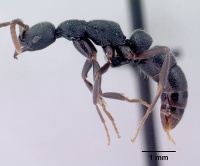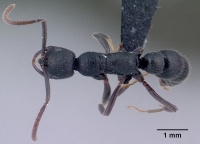Leptogenys vitsy
| Leptogenys vitsy | |
|---|---|

| |
| Scientific classification | |
| Kingdom: | Animalia |
| Phylum: | Arthropoda |
| Class: | Insecta |
| Order: | Hymenoptera |
| Family: | Formicidae |
| Subfamily: | Ponerinae |
| Tribe: | Ponerini |
| Genus: | Leptogenys |
| Species group: | incisa |
| Species complex: | voeltzkowi |
| Species: | L. vitsy |
| Binomial name | |
| Leptogenys vitsy Rakotonirina & Fisher, 2014 | |
Leptogenys vitsy is known from two separate and distant dry forests: Ankoririka of the PN Ankarafantsika in the west and the Makay Mountains in the southwest of the island. Very few records are known for L. vitsy and its biology is unknown, but a small number of workers have been found foraging through the leaf litter.
Identification
A member of the voeltzkowi complex of the incisa species group. Rakotonirina and Fisher (2014) - Worker. Anteromedian clypeal margin characterized by narrowly rounded lobe; peg-like setae present near apical portion, above semi-translucent lamella; antennal scape short (SI< 130); less than one-fourth of its length surpassing posterior margin of head; in full-face view, eye feebly extending beyond outline of lateral cephalic margin; posterior margin of petiolar node with constriction at its posteroventral angle, near junction to gaster; antennal scape and tibia with erect to suberect short hairs; third abdominal tergite densely punctate.
Keys including this Species
Distribution
Latitudinal Distribution Pattern
Latitudinal Range: -16.2672° to -21.2098°.
| North Temperate |
North Subtropical |
Tropical | South Subtropical |
South Temperate |
- Source: AntMaps
Distribution based on Regional Taxon Lists
Malagasy Region: Madagascar (type locality).
Distribution based on AntMaps
Distribution based on AntWeb specimens
Check data from AntWeb
Countries Occupied
| Number of countries occupied by this species based on AntWiki Regional Taxon Lists. In general, fewer countries occupied indicates a narrower range, while more countries indicates a more widespread species. |

|
Estimated Abundance
| Relative abundance based on number of AntMaps records per species (this species within the purple bar). Fewer records (to the left) indicates a less abundant/encountered species while more records (to the right) indicates more abundant/encountered species. |

|
Biology
|
Castes
Nomenclature
The following information is derived from Barry Bolton's Online Catalogue of the Ants of the World.
- vitsy. Leptogenys vitsy Rakotonirina & Fisher, 2014: 102, figs. 48B, 56B, 57A, 110, 126 (w.) MADAGASCAR.
Unless otherwise noted the text for the remainder of this section is reported from the publication that includes the original description.
Description
Worker
(4 specimens). HW: 1.08–1.25, HL: 1.26–1.46, CI: 84–86, SL: 1.22–1.54, SI: 113–126, PW: 0.83–0.94, WL: 2.09–2.47, PNH: 0.76–0.89, PNL: 0.66–0.69, PNW: 0.74–0.81, DNI: 112–118, LNI: 115–132.
Head roughly elongate, slightly wider anteriorly; lateral border weakly convex and rounding into more or less straight posterior margin. Eye medium, very slightly protruding from head surface, and breaking outline of cephalic lateral margin. Antennal scape relatively short. Clypeus with bluntly angulate lateral margin, which taper strongly into narrowly rounded anteromedian lobe; narrow, yellow spot fringing lobe and pair of peg-like setae projecting anteriorly near anteromedial clypeal margin, above lamella. Mandible elongate and slender, nearly straight and without curve near base; blades not capable of closing tightly against clypeus; basal groove a faintly effaced sulcus; preapical teeth either present near apex or absent. With mesosoma in dorsal view, metanotal groove impressed, with cross-ribs; in profile, mesosoma high and short; propodeal lobe indistinct. With petiole in lateral view, node excised or with impression immediatly above posteroventral angle; node about as high as broad, anterior face meeting in convex line with dorsal margin, which in turn makes distinct angle with posterior face. Constriction between third and fourth abdominal segments feeble. Mandible longitudinally striate, interspersed with piliferous punctures; head dorsum densely and finely rugulose-punctate, with sparse larger punctures or foveae. Pronotum finely microreticulate or densely and finely rugose, superimposed with quite dense, large punctures. Rest of mesosoma dorsum and petiolar node densely and finely reticulate-rugose, with scattered shallow punctures. Propodeal declivity transversely rugulose. Third abdominal tergite densely punctate; shallow elongate punctures covering the fourth. Standing hairs and pubescence present on body dorsum; antennal scape and tibiae with short erect or suberect hairs. Black in color, with brown to light brown apices of appendages and tip of gaster.
Type Material
Holotype worker: Madagascar, Mahajanga, PN Ankarafantsika, Réserve d'Ankoririka, 10.6 km 13° NE de Tsaramandroso, -16.2672, 47.0486, 210 m, tropical dry forest, sifted litter, 9–14 Apr 2001 (Fisher, Griswold et al.), collection code: BLF03664, specimen code: CASENT0470280 (California Academy of Sciences). Paratype worker: same data as holotype but with specimen code: CASENT0470279 (CASC).
References
- Rakotonirina, J.C. & Fisher, B.L. 2014. Revision of the Malagasy ponerine ants of the genus Leptogenys Roger (Hymenoptera: Formicidae). Zootaxa 3836, 1-163.
References based on Global Ant Biodiversity Informatics
- Rakotonirina J. C., and B. L. Fisher. 2014. Revision of the Malagasy ponerine ants of the genus Leptogenys Roger (Hymenoptera: Formicidae). Zootaxa 3836 (1): 001163.


